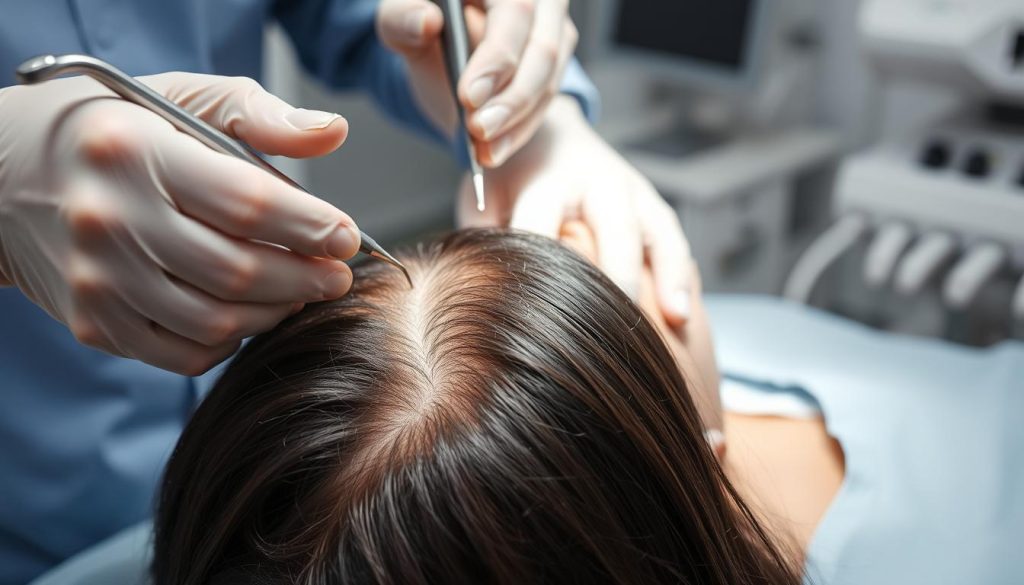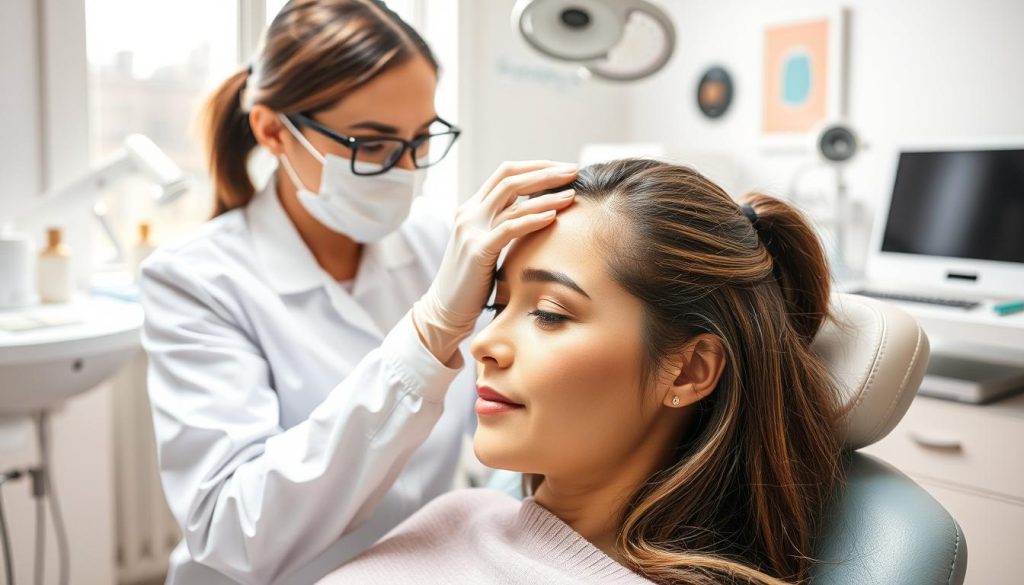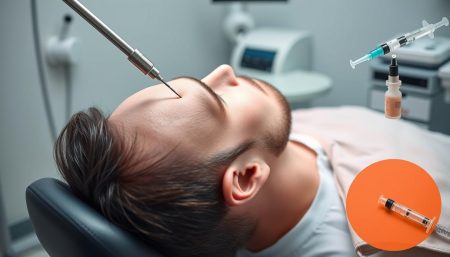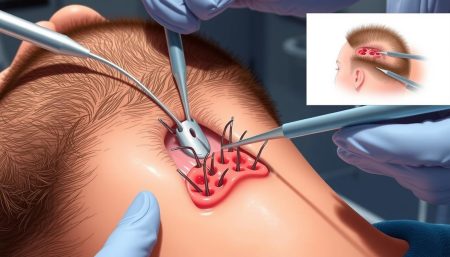For many women, having a full head of hair is more than beauty. It’s a key part of their identity and how they express themselves. The hair transplant for women benefits are now getting more attention. These procedures offer a chance to regain what’s been lost.
Thanks to advanced surgical methods, natural-looking hair restoration is now possible for women. This was once seen as a luxury for men. Now, women facing hair loss have new hope and confidence.
The American Hair Loss Association has seen a rise in women looking for hair transplant solutions. This shows a change in how society views hair loss and the technology available. The Journal of Psychological Research on Cyberspace also highlights the emotional impact of hair loss on self-esteem.
So, more women are choosing hair transplants to boost their self-esteem and enhance their life quality.
The success of this trend comes from advanced techniques and a personalized approach. Specialists understand that every woman’s hair loss story is different. They help women see hair transplants as a step towards better physical and emotional health.
Understanding Hair Loss in Women
Hair loss in women is complex, with many causes and big effects. Genetics and environment play big roles in alopecia in women. Knowing about its types, effects, and mental impact helps support those dealing with it.
Types of Female Hair Loss
Female pattern baldness, or androgenetic alopecia, is the most common. It affects many women around the world. Other types, like Telogen Effluvium and Traction Alopecia, also cause problems. Each type needs its own care and attention.
Impact of Hair Loss on Women
The emotional toll of hair loss on women is huge. Hair loss can make people feel stressed and anxious. It affects not just the scalp but also daily life, making it harder to feel good about oneself.
Psychological Effects of Female Pattern Baldness
The mental impact of female pattern baldness is deep. It can lower self-esteem and make people withdraw socially. It’s important to understand these effects to help those affected fully.
Exploring the types, impacts, and mental effects of hair loss shows it’s more than a medical issue. It needs compassion and understanding to truly help the women it affects.
What Is a Hair Transplant for Women?
A hair transplant for women is a special hair restoration solution for women’s hair loss. It moves hair follicles from thick areas to thin ones. This makes hair look fuller and more natural.

The hair transplant process begins with a detailed talk with a specialist. They check your hair and scalp health and plan the best way to help you. This surgery is done under local anesthesia to boost your confidence and mood.
- Hair is taken from the back of the scalp, where it’s thicker.
- Then, these hairs are carefully moved to thin or bald spots on top.
- After the surgery, you’ll see the full results in a few months as the hair grows.
Choosing a well-known clinic means you get help every step of the way. They use the latest methods to make the transplant smooth and painless. Everyone’s results are different, but the goal is always a full, natural-looking hair.
Getting a hair restoration solution like this can change a woman’s life. It’s not just about looks; it’s about feeling good inside too. This shows how powerful surgical hair recovery for women can be.
Differences Between Male and Female Hair Restoration
Hair restoration has made big strides, focusing on gender-specific hair restoration. Knowing the differences between male and female treatments makes them better. It also leads to better results for patients.
Unique Challenges in Women’s Hair Transplant
Women face a big challenge in personalized female hair transplant techniques. They often deal with widespread thinning, unlike men’s more focused loss. This calls for a careful plan to make the results look natural and cover more ground.
Surgical Approaches Tailored for Females
Also, surgeries for women need to be adjusted for female scalp characteristics. Women have finer hair and different growth patterns. This means doctors must plan carefully and place each follicle with precision.
The table below shows why different strategies are needed for men and women in hair restoration. It highlights the importance of personalized approaches.
| Factor | Male | Female |
|---|---|---|
| Pattern of Hair Loss | Receding hairline and/or bald patch on crown | General thinning across a wide area |
| Scalp Characteristics | Often denser and more resilient | Finer texture, sensitive scalp |
| Surgical Planning | Focused on specific areas | Comprehensive coverage needed |
| Technique Sensitivity | Standardized across similar cases | Highly customized per patient |
Exploring Hair Transplant Options for Women
Looking into female hair replacement solutions means checking out new hair transplant methods. Each one has its own benefits, fitting different needs and results.
Methods range from old-school strip harvesting to newer Follicular Unit Extraction (FUE). These changes help women get natural-looking hair with less pain. Doctors create custom hair transplant plans based on the patient’s hair type, loss, and beauty goals.
New tech offers less painful but effective ways to fight female hair loss. Here’s a quick look at some top female hair replacement solutions:
| Technique | Benefits | Considerations |
|---|---|---|
| Follicular Unit Transplantation (FUT) | Maximizes hair volume | Requires longer recovery time |
| Follicular Unit Extraction (FUE) | Minimal scars, speedy recovery | Can be more costly, multiple sessions may be needed |
| Scalp Micropigmentation (SMP) | Immediate cosmetic enhancement | Does not actually regrow hair |
These innovative hair transplant techniques improve looks and confidence. For custom hair transplant plans, talking to skilled surgeons is key. They help pick the best method for your health and goals.
Are You a Candidate for Female Hair Transplant Surgery?
Figuring out if you’re right for female hair transplant surgery takes a detailed look at several key points. This step is key to make sure the surgery works well and you’re happy with the outcome. Let’s explore what makes you a good candidate.
Evaluating Hair Loss and Donor Areas
First, a detailed check of the donor area is done. Experts look at the back of your head to see how strong and healthy your hair follicles are. These areas usually don’t get bald as easily and are important for a good transplant.
This check helps decide how to do the surgery and how likely it is to succeed.
Understanding the Role of Hormones in Hair Transplant Eligibility
Hormones play a big role in how healthy your hair is and how well a hair transplant will work. Knowing how hormones affect hair is important. Hormonal imbalances can make the transplant less effective.
A test to see how hormones are affecting your hair is done. This helps predict how well the surgery will do and plan the treatment for lasting results.
Hair Transplant for Women Cost Considerations
When thinking about a hair transplant for women cost, it’s important to know it changes a lot. The cost depends on how much hair is needed, the method used, and where the clinic is. It’s key to plan your finances well to cover all costs.
Costs aren’t just for the surgery. They also include follow-up visits and treatments. The skill of the surgeon and how many grafts are needed also affect the price a lot.
| Cost Factor | Description | Impact on Total Cost |
|---|---|---|
| Technique Used | The choice between techniques like FUE and FUT | Can vary the cost by several thousand dollars |
| Geographic Location | Cost varies by country and city | Higher in metropolitan areas |
| Surgeon’s Experience | More experienced surgeons command higher fees | Significant impact based on reputation and success rates |
| Number of Grafts | Depends on desired density and coverage area | Higher number of grafts increases costs |
| Additional Treatments | Includes any post-operative care or supplemental treatments | Additional costs depending on patient’s healing and care needs |
Looking for cost-effective hair transplant options is important. Many clinics offer payment plans to help with the cost. This makes the procedure more affordable for more people.

In conclusion, the hair transplant for women cost needs careful thought. Knowing all the factors and looking into financing options can make the process less stressful.
The Procedure of Hair Transplant Surgery for Females
The journey to regain hair through a female hair transplant procedure is detailed. It involves careful planning to ensure success and safety. Knowing each step helps those thinking about this treatment feel more at ease.
Pre-Surgery Preparation
First, a thorough consultation sets the stage for a successful transplant. This includes medical checks and talks about what you hope to achieve. The team then creates a custom hairline design. They plan every detail to match your face and style.
Step-by-Step Hair Transplant Procedure
The hair transplant surgery steps are broken into several important parts:
- Harvesting grafts from the donor area,
- Preparing the recipient sites, and
- Implanting the grafts with great care.
Each step is done with precision. This ensures the new hair looks natural and feels right.
Post-Operative Care and Recovery
After surgery, the focus is on recovery after hair transplant. This is key for the procedure’s success. Patients may need to take medicine, use special shampoos, and avoid certain activities. The recovery time varies, but the results of the new hair growth are seen months later.
| Phase | Description | Duration |
|---|---|---|
| Pre-Surgery | Consultation, medical evaluation, planning | 1-2 weeks |
| Surgery | Harvesting, site preparation, implantation | 3-8 hours |
| Recovery | Post-operative care, monitoring hair growth | Several months |
Selecting the Best Hair Transplant Clinic for Women
Choosing the right hair restoration clinic is key, more so for women facing unique hair loss challenges. A good clinic boosts your chances of a successful transplant. It also makes the process comfortable and supportive. Here are important things to think about when making this choice.
Criteria for Choosing a Top Clinic
Finding the best hair transplant clinic for women means looking at several important factors. A clinic’s reputation and credibility are top priorities. Look for one with a history of great results and happy patients.
It’s also vital to check the medical team’s experience and qualifications. They should know how to handle female hair loss well. Also, the clinic should use the latest technology like FUE and FUT. These methods give better results with less downtime.
Questions to Ask During Consultation
A detailed consultation for hair transplant is key to understanding the procedure. It’s smart to have a list of questions ready. This ensures you get all the information you need.
- What are the surgeon’s qualifications and experience in female hair restoration?
- Can the clinic show me before-and-after photos of previous patients?
- What hair transplant methods are recommended for me and why?
- What should I expect for recovery time and follow-up care?
These questions help you see if the clinic is open and effective. They help you make a well-informed choice.
| Criteria | Questions to Ask |
|---|---|
| Surgeon’s Qualifications | What is your experience with female hair transplants? |
| Technology Used | What technologies do you use for hair transplantation? |
| Patient Testimonials | Can you show me before-and-after photos of recent female patients? |
| Recovery Process | What is the expected recovery time for the procedure I am considering? |
Choosing the right hair transplant clinic for women requires careful thought. But it’s essential for the best results. With the right information and questions, you can find a clinic that fits your needs.

What to Expect: Women’s Hair Transplant Before and After
When thinking about a hair transplant, women need to know what to expect. The journey to thicker hair is a gradual one. Understanding the before and after hair restoration stages can make you happier with your women’s hair transplant results.
First, talk to a surgeon who knows about female hair loss. They can show you before and after photos of their work. These pictures help set realistic goals for your hair.
The American Academy of Cosmetic Surgery says it’s key to talk about what you can expect. This helps match your hopes with what’s possible.
- Evaluation of the individual’s hair loss type and pattern.
- Detailed discussion on the possible density and coverage.
- Review of the timeline for hair growth after the transplant.
After the transplant, you might see some hair fall out. This is normal and not a sign of failure. It’s part of the healing process.
| Stage | Expectations |
|---|---|
| 0-3 Months | Little to no visible growth; some original hair may shed. |
| 3-6 Months | Initial signs of new hair growth. |
| 6-12 Months | Noticeable hair growth and thickening. |
| 12+ Months | Fullest growth achieved; assessment of need for possible touch-ups. |
By having realistic expectations for hair transplants, women can better prepare for the journey. It’s a time of change, both physically and emotionally. Be patient, as it can take a year or more to see the full results.
The Clinical Journal of Women’s Health talks about the progress of several cases. It shows how different people’s hair grows, highlighting the importance of patience and a realistic view.
Talking about before and after hair restoration photos helps set a clear expectation. This can lead to greater satisfaction with your women’s hair transplant results.
Minimally Invasive Hair Transplant Techniques for Women
In the world of hair restoration, there’s a big push for minimally invasive hair restoration methods. These are designed to meet the unique needs of women dealing with hair loss. Techniques like FUE for women and FUT hair transplant have changed the game. They make the process less harsh.
Follicular Unit Extraction (FUE) is a top choice in hair restoration. It takes single hair follicles from a donor area. This method is great because it leaves little to no scarring. It’s also perfect for those who like shorter haircuts.
FUE for women is known for quick recovery and less pain after the procedure. This is compared to older methods.
FUE (Follicular Unit Extraction)
Choosing FUE for women means small, circular cuts are made around each hair follicle. This is done carefully to avoid harming the scalp. It helps keep the natural look and boosts the chances of successful hair growth.
FUT (Follicular Unit Transplantation)
The FUT hair transplant method takes a strip of skin from the back of the head. It’s then cut into individual follicles. This method is a bit more invasive but can handle more hair loss in one go.
Choosing between FUE and FUT depends on several things. These include how much hair is lost, the scalp’s flexibility, personal style, and lifestyle. Both methods aim to give the best results with as little discomfort as possible.
Thanks to these advancements, women have more options for hair loss. These options are tailored to meet both aesthetic and medical needs.
Risks and Side Effects of Hair Transplants in Women
Hair transplants offer hope for those dealing with hair loss. Yet, they come with hair transplant risks and side effects. Knowing about these can help people make better choices for their hair restoration.
The hair restoration safety profile is a big concern. The procedure is usually safe when done by experts. But, like any medical treatment, it can have risks. These include infection, scarring, and an unnatural hairline if not done right.
- Swelling and bruising at the transplant site
- Numbness or mild pain at the donor or transplant areas
- Temporary shedding of transplanted hair, medically known as shock loss
These side effects usually go away in a few days to weeks. But, serious problems, though rare, can happen. This includes the transplanted hair not growing. It’s key to talk about these hair transplant risks with a surgeon before the procedure.
It’s also important to look at the hair restoration safety profile by checking clinical studies and real patient results. Here’s a table showing common risks of hair transplants:
| Side Effect | Frequency | Severity | Management Approach |
|---|---|---|---|
| Swelling | Common | Mild | Typically resolves within several days; ice packs can reduce swelling. |
| Pain | Common | Mild to Moderate | Managed with prescribed pain relievers. |
| Infection | Rare | Can be severe | Antibiotics and proper wound care are essential. |
| Scarring | Uncommon | Moderate | Surgical technique and post-operative care are important. |
| Unnatural Hairline | Rare | Moderate to Severe | Pre-surgical planning and skilled surgical execution are critical to avoid this. |
While serious problems are rare, they show why choosing a skilled surgeon is key. This choice greatly affects the hair restoration safety profile.
In summary, hair transplant risks are manageable with a good surgeon and patient care. Knowing all about side effects helps patients make smart choices for their hair restoration.
Female Pattern Baldness Treatment Beyond Transplants
Looking into treatments for female pattern baldness goes beyond surgery. It includes medical treatments, alternative therapies, and lifestyle changes. These help grow hair and keep the scalp healthy.
Medical Treatments and Alternative Therapies
Medicines like minoxidil are key in treating female pattern baldness. But, many look for non-invasive options. Platelet-Rich Plasma (PRP) therapy is popular for using the body’s growth factors to wake up hair follicles.
Scalp micropigmentation is another choice. It offers a cosmetic fix for thinning hair without surgery.
Lifestyle Changes for Hair Health
Changing your lifestyle is important for managing female pattern baldness. Eating a balanced diet with vitamins and minerals is key. Stress management and avoiding harsh hair treatments also help.
| Treatment Type | Description | Benefits |
|---|---|---|
| Minoxidil | Topical medication applied to the scalp | Promotes hair growth and slows balding |
| PRP Therapy | Injections of platelet-rich plasma into scalp | Stimulates natural hair growth factors |
| Dietary Changes | Incorporation of hair-healthy nutrients | Supports follicle health and prevents further hair loss |

Real Stories: Success Rates and Testimonials
Looking at hair transplant success stories and patient testimonials can change doubts into confidence for those thinking about it. We’ll explore some real hair transplant experiences. Women share their paths from losing hair to getting it back, showing both the emotional and physical changes.
Each story highlights different hair transplant methods and their success rates. These stories show not just the chance for big hair improvements but also the care needed after the procedure. By sharing these successes, people can understand what the journey is like and what to expect for themselves.
| Type of Procedure | Success Rate | Notable Patient Feedback |
|---|---|---|
| Follicular Unit Extraction (FUE) | 98% | An extensive satisfaction among patients, highlighting minimal scarring and natural-looking results. |
| Follicular Unit Transplantation (FUT) | 96% | Favorable reviews due to cost-effectiveness and efficiency for covering larger areas. |
| Robotic Hair Transplantation | 99% | Praise for precision and reduced human error, with quicker recovery times. |
These real hair transplant experiences create a supportive community. Women find comfort and reassurance in others’ stories. The patient testimonials from The Hair Society show high success rates and emotional support from top clinics.
If you’re thinking about a hair transplant, reading these hair transplant success stories is key. Knowing the different outcomes and what affects success can help you prepare for your own journey.
Maintaining Results: Post-Transplant Hair Care
The journey to restore your hair doesn’t stop after surgery. It requires careful hair care after transplant. You must wash your hair gently with the shampoos your surgeon recommends. This protects your sensitive scalp and helps the new grafts grow.
Stay away from harsh treatments like chemical colors. Also, avoid direct heat on your scalp. This keeps the new follicles safe during their healing and growth.
To keep your hair transplant looking good, you might need long-term care. This could include medications or treatments to prevent hair loss. Always follow your surgeon’s post-surgery instructions closely. This is key to the success and longevity of your transplant.
Following your surgeon’s advice is backed by studies. The Archives of Plastic Surgery journal agrees that these care plans are essential for the best results.
Regular check-ups with your hair specialist are also important. These visits help track the growth and health of your transplanted hair. As Practical Dermatology notes, a consistent care routine is vital after a transplant.
By taking good care of your hair post-transplant, you ensure its health. This also extends the life of your transplant. So, you can enjoy your new, natural look for many years.
FAQ
Q: What are the benefits of a hair transplant for women?
A: A hair transplant can give women a natural-looking hairline. It fills in thinning areas and boosts self-esteem. Advanced techniques help address hair loss, leading to increased confidence.
Q: What causes hair loss in women?
A: Hair loss in women comes from genetics, hormonal changes, and environmental factors. Causes include Androgenetic Alopecia, Telogen Effluvium, and Traction Alopecia.
Q: How does female pattern baldness affect women psychologically?
A: Female pattern baldness can deeply affect a woman’s mental health. It leads to emotional distress and a lower self-image. The emotional toll of hair loss can greatly impact a woman’s life.
Q: What does a hair transplant procedure for women involve?
A: A hair transplant moves healthy hair from a donor site to thinning areas. The goal is a natural hairline and density. It’s done on an outpatient basis with local anesthesia for comfort.
Q: What are the unique challenges in women’s hair transplant?
A: Women’s hair transplant faces challenges like wider thinning areas. It requires a detailed approach to design a natural hairline. Grafts are placed to mimic natural growth.
Q: How do surgical approaches differ for female hair restoration?
A: Surgical methods for women are tailored for diffuse hair loss. They aim to use donor hair wisely and preserve natural hairlines. The goal is a result that fits the individual’s scalp.
Q: What hair transplant options are available for women?
A: Women have several transplant options, like traditional strip harvesting and follicular unit extraction. The best choice depends on hair loss, type, and desired look. New technologies make procedures more effective and less invasive.
Q: How is eligibility for hair transplant surgery in women determined?
A: Eligibility is based on hair loss degree, donor hair quality, hormonal balance, and health. A thorough medical check is needed to ensure suitability for the procedure.
Q: What are the cost considerations for women’s hair transplant?
A: The cost varies based on transplant extent, technique, surgeon’s experience, and location. Patients should consider all costs, including post-op care. Many clinics offer financing options.
Q: What does the hair transplant surgery procedure entail for females?
A: The procedure includes consultations, graft harvesting, and implanting. It also involves post-op care for recovery and successful results.
Q: How do I choose the best hair transplant clinic for women?
A: Choose a clinic by researching the team’s reputation and experience. Look at technology and patient results. Check for accredited clinics and read reviews.
Q: What should I expect before and after a women’s hair transplant?
A: Before and after, understand hair growth stages and density. Surgeons will discuss expectations and provide examples. This helps set realistic goals.
Q: What are minimally invasive hair transplant techniques for women?
A: Techniques include FUE and FUT. FUE is quicker with less recovery, while FUT offers more grafts. Both have benefits depending on the case.
Q: What are the risks and side effects of hair transplants in women?
A: Risks include infection, scarring, and unnatural hairlines. Side effects are swelling, pain, and temporary hair loss. Discuss these with a surgeon to understand risks.
Q: What are some treatments for female pattern baldness beyond transplants?
A: Options include minoxidil, PRP, scalp micropigmentation, and wigs. Lifestyle changes also promote hair health.
Q: What do hair transplant success rates and testimonials reveal?
A: Success rates and testimonials show the procedure’s effectiveness. Personal stories help set recovery expectations and show different outcomes.
Q: How should I care for my hair after a transplant?
A: Aftercare includes gentle washing and avoiding harsh treatments. Follow the surgeon’s instructions and attend follow-up visits to maintain results.


















